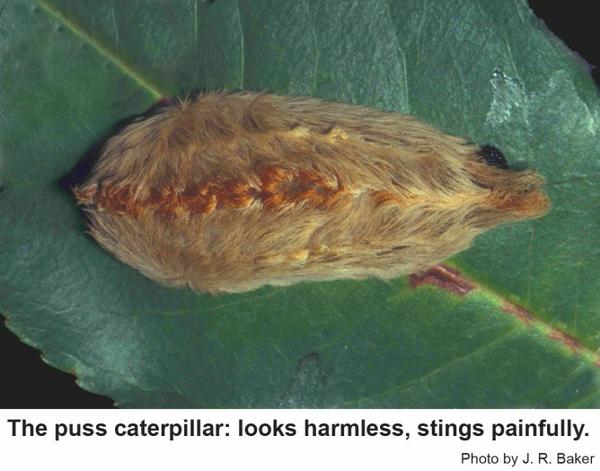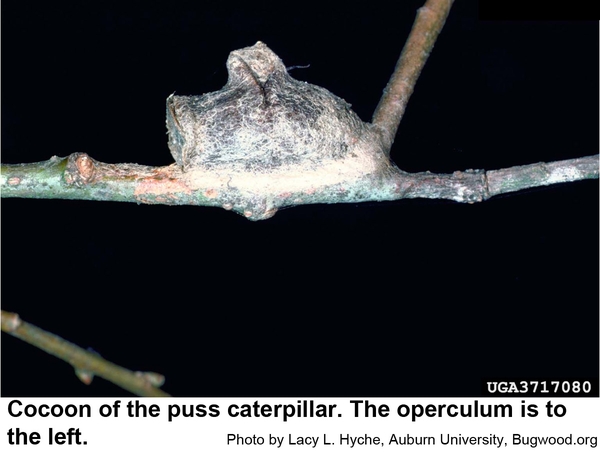Description and Biology
Puss caterpillars, Megalopyge opercularis, are also called asp caterpillars because of their potent stings. They are called puss caterpillars because their thick, fluffy setae resemble the fur of a pussycat. Adults are called flannel moths because of their fluffy, wavy, flannel-like scales. The moths evidently lay their eggs in batches because young larvae sometimes feed in groups on the surface of the leaf. Older larvae devour entire leaves. Two generations occur each year with peaks of abundance of caterpillars in July and October. Second generation caterpillars finally spin a dense cocoon on the host plant in which they spend the winter. The cocoon usually has a noticeable bump on the back and on the front there is usually a distinct, round hatch cover (the operculum) through which the moth emerges in the spring (the scientific name opercularis was named for the distinctive operculum.).
Host Plants
Puss caterpillars feed on various deciduous trees and shrubs, especially elm, hackberry, maple, oak, and sycamore. Puss caterpillars are usually not abundant enough to be noticed although rare outbreaks have been widespread causing severe defoliation. On humans, they produce a very painful sting when brushed against (brushing against the caterpillar breaks tiny hollow spines filled with an urticating fluid that produces a painful stinging sensation. The pain may last several hours. Swelling associated with the sting may be evident for several days). Other symptoms aside from pain, stinging, and swelling are nausea, headache, fever, itching, abdominal distress, chest pain, difficulty breathing, numbness, vision problems. Other than that, the sting is not troublesome.
Residential Recommendation
Puss caterpillars are usually not abundant enough to be noticed although rare outbreaks may be widespread and may cause severe defoliation. Sevin or one of the Bacillus thuringiensis pesticides should give adequate control although Bt is not very effective on older caterpillars.
References
- Common name: puss caterpillar (larva), southern flannel moth (adult), scientific name: Megalopyge opercularis (J. E. Smith 1797) (Insecta: Lepidoptera: Zygaenoidea: Megalopygidae). Hall, D. W. 2012 (revised 2019). Featured Creatures. Entomology & Nematology, FDACS/DPI, EDIS.
- Envenomation by the asp caterpillar (Megalopyge opercularis). Eagleman, D. M. 2007. Clinical Tocicology. 1. pp. 1-5.
- Insect and Other Pests of People and Animals, 2nd edition. Baker, J. R., C. S. Apperson, and J. J. Arends, editors. 2000. N.C. Cooperative Extension Service publication AG-369. 92 pp.
- Extension Plant Pathology Publications and Factsheets
- Horticultural Science Publications
- North Carolina Agricultural Chemicals Manual
For assistance with a specific problem, contact your local N.C. Cooperative Extension Center.
This Factsheet has not been peer reviewed.
Publication date: June 27, 2013
Reviewed/Revised: May 8, 2023
Recommendations for the use of agricultural chemicals are included in this publication as a convenience to the reader. The use of brand names and any mention or listing of commercial products or services in this publication does not imply endorsement by NC State University or N.C. A&T State University nor discrimination against similar products or services not mentioned. Individuals who use agricultural chemicals are responsible for ensuring that the intended use complies with current regulations and conforms to the product label. Be sure to obtain current information about usage regulations and examine a current product label before applying any chemical. For assistance, contact your local N.C. Cooperative Extension county center.
N.C. Cooperative Extension prohibits discrimination and harassment regardless of age, color, disability, family and marital status, gender identity, national origin, political beliefs, race, religion, sex (including pregnancy), sexual orientation and veteran status.



